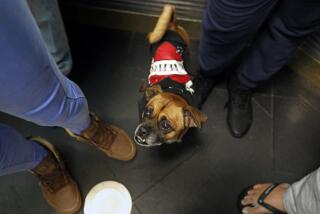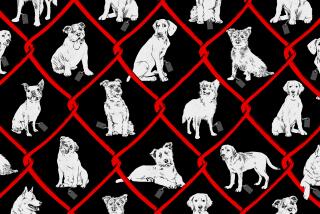Manikin a dog’s best friend
Even in this town you would think there would be more than six degrees of separation between Woody Woodpecker and a Bovine Rectal Palpation Mannikin. But, in fact, there’s only one. Woody, of course, is a beloved cartoon character and mascot of Universal Studios; Bovine, a teaching tool coming soon from Rescue Critters, a 5-year-old company that designs and manufactures manikins used to teach animal rescue, CPR and veterinary skills. The single degree that separates them is Craig Jones, president of Rescue Critters, who has had working relationships with both.
Jones has followed a career path indigenous to Los Angeles, the sort that wanders in and out of the entertainment industry, occasionally gets lost amid the bird of paradise and sometimes winds up in a 16-bedroom Malibu estate. For now, this path has taken Jones to a neat California bungalow in Lake Balboa. But you never know how a story that involves a stuffed dog called Advanced Airway Jerry is going to end.
This is how it began. In 1991, Jones was a production stage manager at Universal Studios. There he met many people in the backstage part of the business -- costume designers, special effects artists, seamstresses. These included Jacqueline Pruneda, who worked on costumes for the Universal tour and the walk-around characters, and who became Jones’ girlfriend and later his wife.
While working part-time for Universal, Jones also entered a psychiatric technician apprenticeship at Camarillo State Hospital. He eventually quit the biz and in 1995 was working at the hospital full time and teaching CPR courses for the Red Cross. When an injury benched him from the hospital, he tried to figure out what he should do next.
Out of curiosity, he went to a class on pet first aid. He was struck by the fact that the instructor was using a stuffed animal rather than an anatomical model. The instructor told him there was no such thing and Jones could not understand this. How hard would it be to make a canine CPR manikin?
Well, not terribly when your wife and her friends can whip up larger-than-life versions of characters such as Woody. So Jones put together a five-person team, maxed out his credit cards, made friends with some veterinarians and, in a few months, Jerry, a K-9 CPR manikin, emerged from his garage.
Jerry was named for an actual dog owned by Christine Knapp, a costume and makeup artist who is now a partner in Rescue Critters. Jerry has working lungs and an artificial pulse and can be used to practice mouth-to-snout resuscitation, splinting and bandaging. He is brown and just shy of FAO Schwarz cute. According to Jones, the Red Cross was thrilled -- Rescue Critters made about 40 Jerrys that year and quickly followed up with Fluffy, the feline version. Soon veterinary schools from around the world were calling.
Many veterinarian students practice how to suture and aspirate, how to anesthetize and insert IVs and catheters on live animals. Neither Jones nor any of his five partners considered themselves anti-vivisectionists when they started the company, but they subsequently have embraced the Animal Welfare Act’s call to “refine, reduce and replace” live animals in veterinary training as part of their official mandate, and not just because it is profitable for the company.
“We do love animals,” says Pruneda, the company’s vice president. She is sitting in the office that once was her family room and she leans down to pet Emily, the street dog she and Jones adopted a few years ago. “You have to start somewhere to make the world a better place,” Pruneda says. “And a society that treats animals humanely seems like a good place to start.”
Moral complexities aside, animal manikins, Jones says, can just be cheaper for schools and more practical.
“A live animal is not the best teaching tool,” says Laura Rasmussen, director of surgery and clinical skills at Western University of Health Sciences’ College of Veterinary Medicine. “It’s so complex. It’s like taking a flying novice and putting them in the cockpit and expecting them to fly a plane.”
Rasmussen has spent the last four years putting together a curriculum for the college which, in September, will become the first veterinary medicine school in Southern California, the second in the state. Her methodology, she says, does not allow the use of “animals for the detriment.” But when she began looking for tools to make this work, she discovered what Jones had -- that there wasn’t a whole lot on the market. She contacted Rescue Critters and worked with Jones to develop other models.
“The Female K-9 Urinary Catheter Training Mannikin,” says Rasmussen, “that was my idea.” One of her colleagues is working on the Bovine Rectal Palpation Mannikin -- used to teach students how to gauge, among other things, a cow’s pregnancy.
Jones does not confine himself to the needs of veterinarians. One of the company’s best sellers is Fetch, the K-9 search-and-rescue manikin. A full-sized German shepherd, Fetch is used to train police, animal regulation officers and firefighters how to extricate trapped dogs. Search-and-rescue teams as well as police and military K-9 units around the world also have used him to teach their members how to rappel with a rescue dog. (Fetch comes with a specially designed rappelling harness.)
Much of the work is still done in Jones’ garage workshop, which looks much like anyone’s garage workshop, except for the bowl full of dog paws on the bench. And the unattached silicon tongues on one shelf. And the plastic skulls and box of fake animal fur on another.
Jones pulls out the latest version of Jerry -- a model that can teach dog owners how to feel for their pet’s pulse. “People think the neck,” he says, “and that’s wrong. It’s right here,” he says, putting his fingers near the dog’s groin and pumping an attached red bulb so a tube inside pulses convincingly.
He has a lot of other models in research and development including a nursing manikin that would allow abandoned litters of puppies or kittens to eat and cuddle together. Then there’s his piece de resistence -- Lucky the rescue horse. Designed to train firefighters and rescue teams how to cope with trapped or wounded horses, Lucky is a full-sized horse with realistically movable parts. He breaks down to fit in a crate and there is one of these crates in the trailer parked beside Jones’ garage. On top of the crate is a large duffel bag that, in an unnerving “Godfather” sort of way, clearly contains the horse’s head.
Products on the Rescue Critters Web site (www.rescuecritters.com) range from $30 for the suture arm to $895 for the CPR Jerry to $5,675 for Lucky the horse. “The British and the Australians really love Jerry,” says Jones. Also on the Web site is the story of the Knapp’s dog, the original Jerry. Before Knapp adopted him, it seems, he too worked at Universal as a former animal actor. Now that he has what is essentially his own line of the coolest action figures around, you have to wonder: “Critical Care Jerry: The Movie”?
More to Read
Sign up for The Wild
We’ll help you find the best places to hike, bike and run, as well as the perfect silent spots for meditation and yoga.
You may occasionally receive promotional content from the Los Angeles Times.







